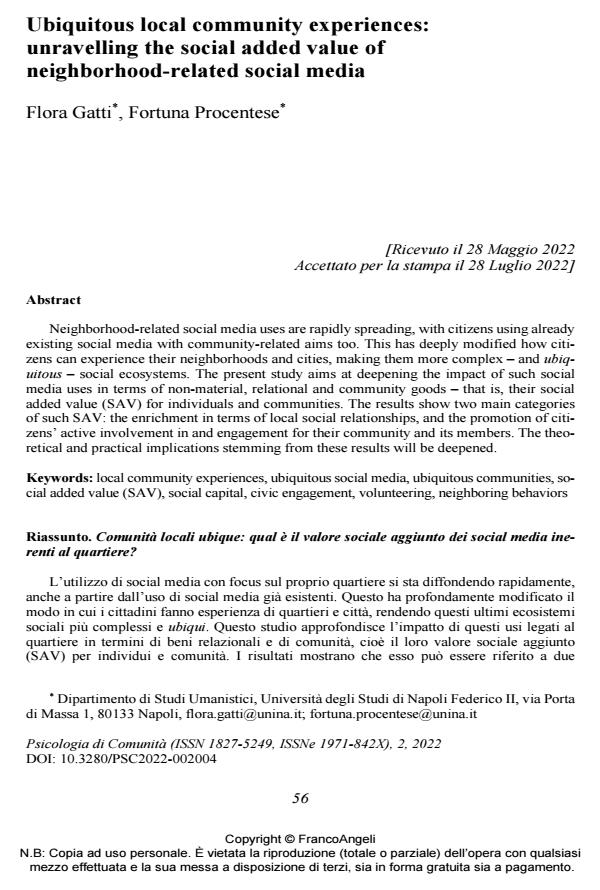Ubiquitous local community experiences: unravelling the social added value of neighborhood-related social media
Journal title PSICOLOGIA DI COMUNITA’
Author/s Flora Gatti, Fortuna Procentese
Publishing Year 2022 Issue 2022/2
Language English Pages 24 P. 56-79 File size 251 KB
DOI 10.3280/PSC2022-002004
DOI is like a bar code for intellectual property: to have more infomation
click here
Below, you can see the article first page
If you want to buy this article in PDF format, you can do it, following the instructions to buy download credits

FrancoAngeli is member of Publishers International Linking Association, Inc (PILA), a not-for-profit association which run the CrossRef service enabling links to and from online scholarly content.
Neighborhood-related social media uses are rapidly spreading, with citizens using already existing social media with community-related aims too. This has deeply modified how citizens can experience their neighborhoods and cities, making them more complex - and ubiquitous - social ecosystems. The present study aims at deepening the impact of such social media uses in terms of non-material, relational and community goods - that is, their social added value (SAV) for individuals and communities. The results show two main categories of such SAV: the enrichment in terms of local social relationships, and the promotion of citizens’ active in-volvement in and engagement for their community and its members. The theoretical and practical implications stemming from these results will be deepened.
Keywords: local community experiences, ubiquitous social media, ubiquitous communities, social added value (SAV), social capital, civic engagement, volunteering, neighboring behaviors
- Ubiquitous processes strengthening neighbourhood communities: How neighbourhood‐related social media can foster the active involvement of citizens and build resilient communities Flora Gatti, Fortuna Procentese, in Journal of Community & Applied Social Psychology e2862/2024
DOI: 10.1002/casp.2862 - Community‐based participatory research for urban regeneration: Bridging the dichotomies through the exp‐EIA method Nicola Rainisio, Marco Boffi, Barbara Piga, Gabriele Stancato, Natalia Fumagalli, in Journal of Community & Applied Social Psychology e2877/2024
DOI: 10.1002/casp.2877 - The power of connection: Resource and responsibility in the virtual community experience of Italian trans and gender‐diverse activists Christian Compare, Maric Martin Lorusso, Cinzia Albanesi, in Journal of Community & Applied Social Psychology e2859/2024
DOI: 10.1002/casp.2859 - What can we learn from critical, liberation, and decolonization community psychologists of the global South? Donata Francescato, in RIVISTA DI PSICOLOGIA CLINICA 1/2024 pp.61
DOI: 10.3280/rpc1-2024oa18168 - “Who Cancelled Lee Highway?”: Expressions of White Racial Frames and Counterframes on Nextdoor Shayna Maskell, in Journal of Ethnic and Cultural Studies /2024 pp.1
DOI: 10.29333/ejecs/1617 - Suicide on Italian Instagram: Insights and implications for prevention and support Martina Olcese, Lorenzo Antichi, Francesco Madera, Paola Cardinali, Davide Prestia, Gianluca Serafini, Davide Dettore, Silvia Casale, Marco Giannini, Giovanni Martinotti, Laura Migliorini, in Journal of Community & Applied Social Psychology e2844/2024
DOI: 10.1002/casp.2844
Flora Gatti, Fortuna Procentese, Ubiquitous local community experiences: unravelling the social added value of neighborhood-related social media in "PSICOLOGIA DI COMUNITA’" 2/2022, pp 56-79, DOI: 10.3280/PSC2022-002004